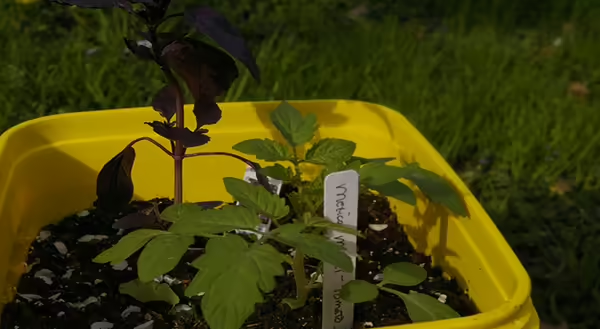
Spring has sprung, the weather is gorgeous, and everyone wants to get outside. However, social distancing measures prevent many of us from being in public spaces. We can’t gather with others, but we still care about our families and our community. What a perfect time to revisit the victory garden and give a whole new meaning to the word VICTORY.
During World War II, food was in high demand, and agricultural production was stretched to its limits. The United States fed our own population, both civilian and military, as well as many of the Allies. Farmers were being called to serve by the draft just as the need for food increased greatly. Many homes quickly became single-parent households, making it even harder to make ends meet.
Tin was crucial for transportation in the war efforts, so canned foods such as fruits and vegetables were rationed beginning in 1940. Civilians were encouraged to grow their own gardens to supplement their rations and can their own foods to stock their pantry shelves.
Not everyone knew how to garden, so the Department of Agriculture produced pamphlets to guide urban and suburban gardeners. Posters were made, magazine articles were written, and committees were formed within individual neighborhoods. Tools were shared, food was grown, and a sense of community and patriotism was encouraged.
Victory gardens became a way for every American family to supply themselves and their community with fresh food. Twenty million victory gardens were planted anywhere there was room-- yards, hanging window boxes, rooftops, even Fenway Park (among many other well-known public spaces). By 1943, American victory gardens generated nearly 40 percent of all vegetables produced in the US!
Fast forward to 2020 and the social distancing efforts that discourage us from leaving home except for essential items. Widespread food insecurity, although not for the same reasons as WWII, is once again a concern. There are far more households relying on just one or even no income today than there were during the war. Due to current circumstances, there are many people laid off or unemployed. Additionally, nutritious fresh foods can be more costly than less healthy, processed foods.
This might be the perfect time to start a garden, even on a small scale. It is not incredibly expensive to plant seeds in a container or yard. There are many resources available, through Extension and elsewhere, to help an individual or family get started. Information, soil, tools, seeds, plants, and support are all readily available in the community.
If a few people on the block get together and make a small plot, they can easily grow more produce than one family can eat in a season. Those who live in apartments can use containers and window boxes. In my own garden, one tomato plant can produce 200 tomatoes in a single season. That’s a lot of spaghetti sauce! If fresh produce were available to every citizen through gardening efforts, trips to the grocery store could be limited even further. By canning what is grown, families could stock their pantries with the literal fruits of their labor.
Asking children to help plant or pull weeds provides the sunshine and physical activity that growing young people desire. Working together and sharing with neighbors can create a sense of community. Donating extras to local food pantries gives back to those in need. Teaching, learning, and helping each other can create pride and ownership in community. And this can all be done within the guidelines of social distancing.
There will come a time when we can triumphantly gather again, hopefully sooner than later. What will you have done to take care of yourself, your family, and your community? Pick a small goal, like one pepper plant in a container, a cherry tomato plant in the back yard, or some herbs growing in your kitchen. Reach out for help when you need it. When we are learning, growing, and supporting each other, even a small garden is a victory.
“I think we should continue our gardens- not only for the food, but for the deep satisfaction they yield. And for the war years the extra food produced by town and city gardeners might be looked upon as insurance- insurance that we will have enough of health-giving fresh vegetables.” Marvin Jones, War Food Administrator, to Victory Gardeners in 1944.
Jacobsen, Linda A, and Mark Mather. “Household Change in the United States.” Population Reference Bureau, 25 Sept. 2012, www.prb.org/us-household-change/.
“Small Agriculture: A National Agricultural Library Digital Exhibit.” Omeka RSS, www.nal.usda.gov/exhibits/ipd/small/exhibits/show/victory-gardens.
Stewart, Hayden, and Jeffrey Hyman. “Fruit and Vegetable Prices.” USDA ERS - Fruit and Vegetable Prices, 28 Nov. 2012, www.ers.usda.gov/data-products/fruit-and-vegetable-prices/.
Know How Know More University of Illinois Extension is the original go-to source for growers, DIYers and jacks of all trades. For more than a century, Illinois Extension expert educators have shared university research in communities across the state. Get advice you can trust on horticulture, agriculture and nutrition in the Know How Know More blog. Build your best life. Trust Extension to help.
Sarah Vogel is the horticulture and natural resources educator for DeWitt, Macon, and Piatt Counties. She specializes in annuals and perennials, greenhouse production, landscaping, and urban forest management. She received a bachelor’s degree from SIUC in Forestry with a concentration in recreation management, and a master’s degree from UIUC in Crop Sciences with a concentration in Horticulture. Sarah’s passion is connecting with underserved populations in the community and fostering appreciation for nature through education. You can contact her via phone 217.877.6042 or email at sarahv@illinois.edu.